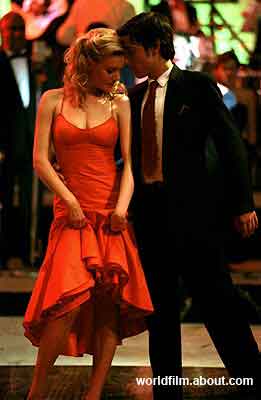
|
|
Dirty Dancing: Havana Nights2004. Lions Gate Films and Miramax Films. Directed By Guy Ferland. Written By Boaz Yakin and Victoria Arch based on story by Kate Gunzinger and Peter Sagal. With Diego Luna and Romola Garai. Katey Miller moves with her family to Havana, Cuba, for her dad's work. She meets Javier Suarez, a waiter who gets fired after dancing with Katey and walking her home. To help Javier, Katey then decides to enter the ballroom-dancing competition with Javier who is the breadwinner of his family. The pair eventually develops a bond on the dance floor - and more. November 1958. Havana, Cuba. Two characters of different nationalities, leading different lives, and living different economic status meet in the height of the Cuban revolution against the military dictator Batista. "She's an American visitor in a place he calls his own. Her life is about rules. His life is about freedom." Music and dance are highlights of the film as musical per se. Particularly, in Havana Nights, music and dance are part of the narrative, in contrast to other musicals, especially straight. We can even say that it is its being a dance film which makes it a musical. Since we see no actor breaking into singing or dancing for no apparent reason, in his or her soliloquy or dialogue with another, Havana Nights may be said to be one of the more realistic films among musicals. While we see no character breaking into singing a song that has to do with the narrative plot, the songs are sung by the characters not by their voices but by their bodies. By feeling the music, they give equal importance to dance and to music which conceives their dances and which stimulates emotions for their bodies to move. Havana Nights as a dance film, thus, a musical, is stylized despite its social context and history of the Cuban revolution. The film's setting may be too serious for a musical, and thus, it follows the exception to the rule, like the West Side Story. However, Havana Nights also shows in some ways how carefree Katey and Javier are despite the situations they are in. There are unnatural scenes worth noticing, as well, like how in most cases, when they start to dance, the music will play automatically when in fact, it does not happen in real life. In addition, despite its realistic characteristic, paradoxically, we see a form of escapism deeply embedded in the same realistic world of the characters. Katey always thinks about catching up in school. She is studious, organized, and quite a conservative young woman from a well-off family. Javier is the breadwinner of his family, supporting his mother and his siblings, after his father has been killed in the ongoing revolution. The truth may be, Katey and Javier are positioned where they rather would not be in. They have a lot of differences, and they have their own restraints: to Javier, his family, the social and political unrest in his country between the military and the rebels, and between Cubans and the foreigners; to Katey, her social-climbing mom, her own inferiority complex, and her confinement to herself and the books. Their qualities that distinguish them from each other, and the bonds tied on them, lead them to one thing that bring them together and make them free - dancing. Their differences are helpful, too, and they learned from each other's differences. Katey, who has been raised by dancer parents know ballroom and the rules. Javier knows dancing by heart, by "[feeling] the music." Dancing has what gives Katey and Javier self-liberation. Feeling the music is seen as tantamount to freeing the body and the soul. The self-liberation they get from dancing with each other has taught them to love dancing with each other, and eventually, loving each other. The film tries to experiment on that as well, exploring how close Katey and Javier can be emotionally, when they dance intimately. And that's where their romance comes in. Havana Nights is about Katey, Javier, the Cuban revolution, which is the conflict and the context, and dancing - the attempt to escape from the conflict. It follows the romantic comedy characteristic and simple formula of the musical, as boy meets girl. Citizens seek for liberation from dancing, as well. In their repressed states, deprived of freedom from the dictatorship and military government of Batista, Cubans take on the streets to dance, express themselves, and feel a certain level of liberation. 
Finally, the revolution that ignited from the people who want to liberate themselves is rewarded. On the one hand, the people have been liberated from Batista through guns and the rebels; on the other, Katey and Javier have found themselves liberated through dance. When Javier confronted his brother for causing a ruckus at The Palace, his brother informed him of a revolution that is going to happen tonight, to which he replies, "Where is the revolution tonight? On the dance floor?" Both revolutions take place that night, indeed. The political liberation sets them apart, however, as Katey and her family have to return to America. Still, it ends as such in a sweet and happy ending. |
| © 2009 Kris Rajani Nagera |